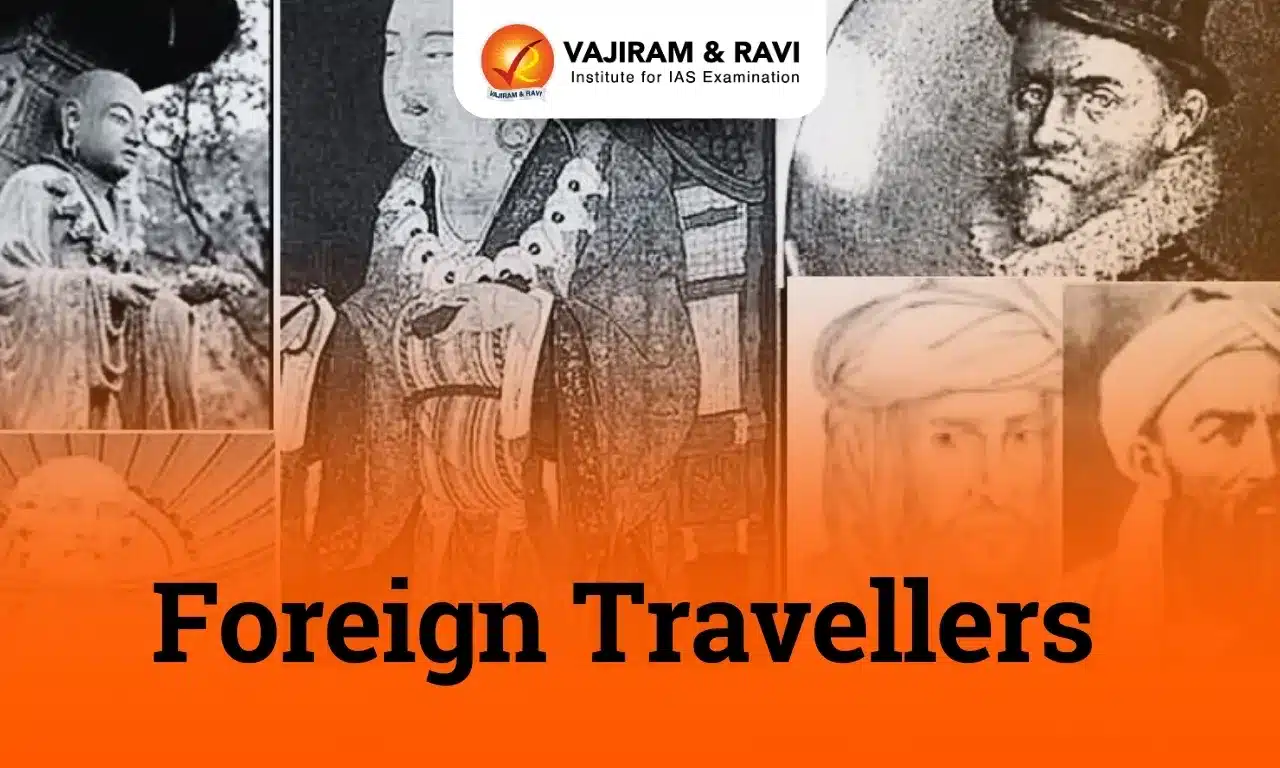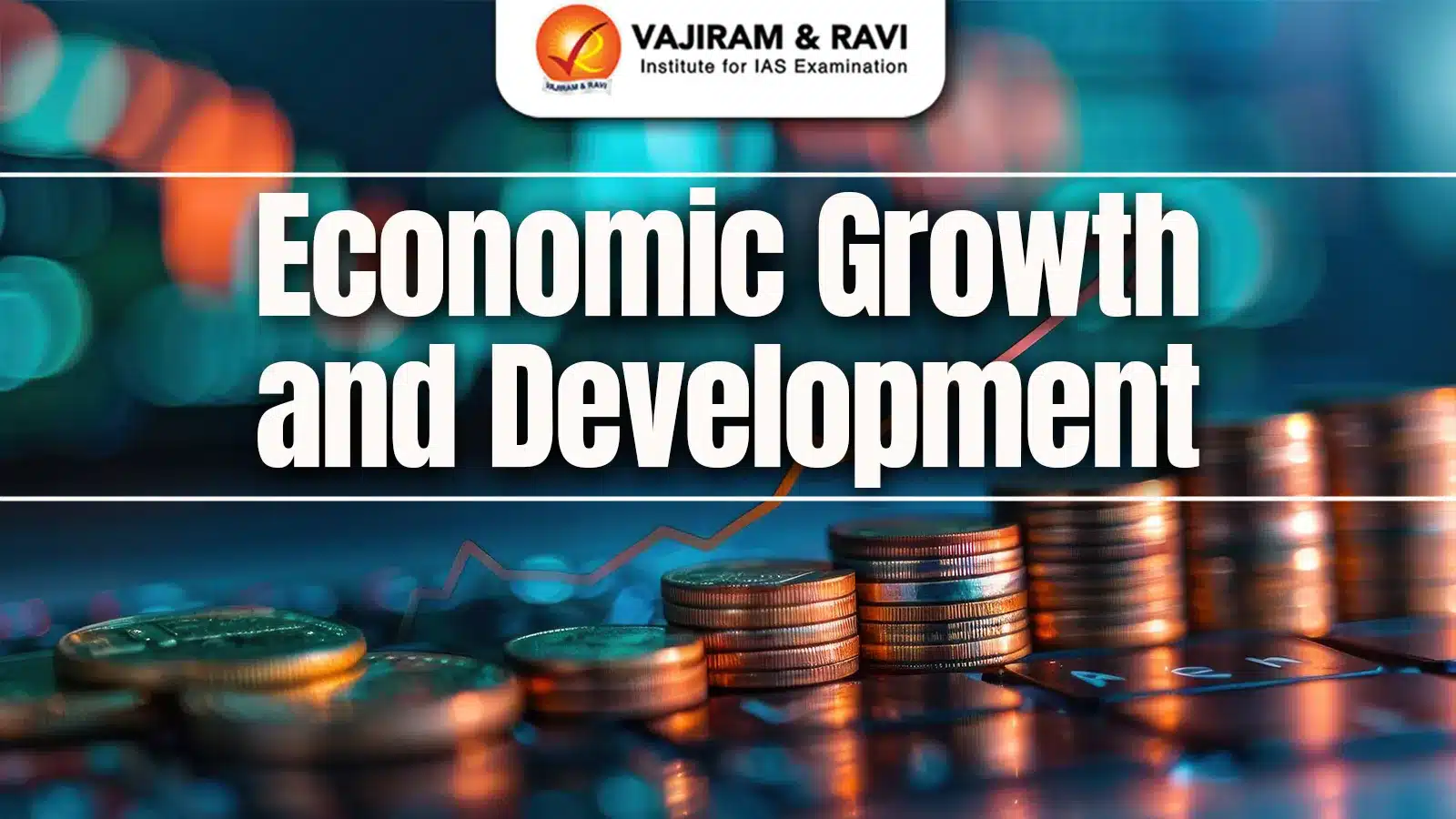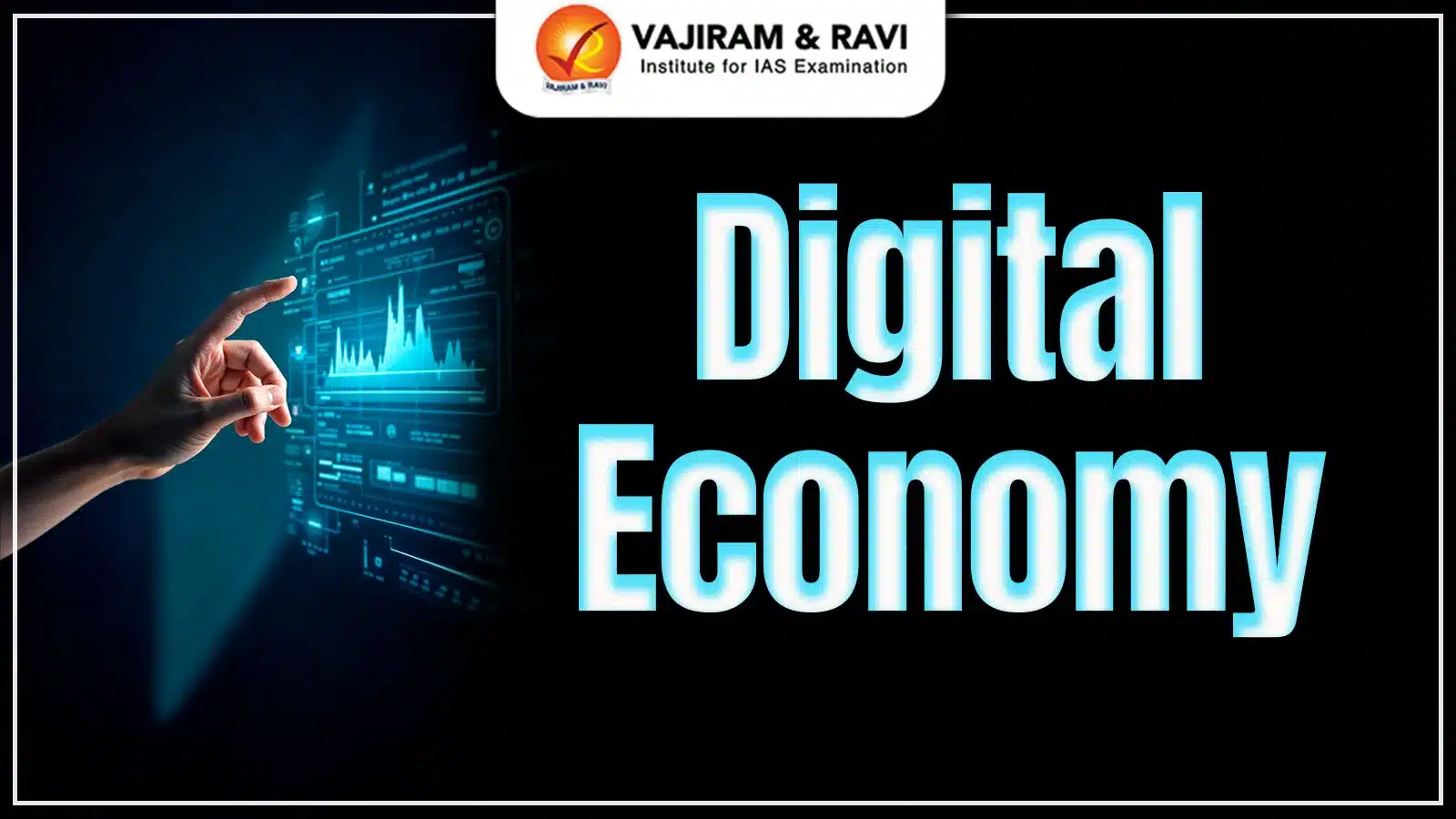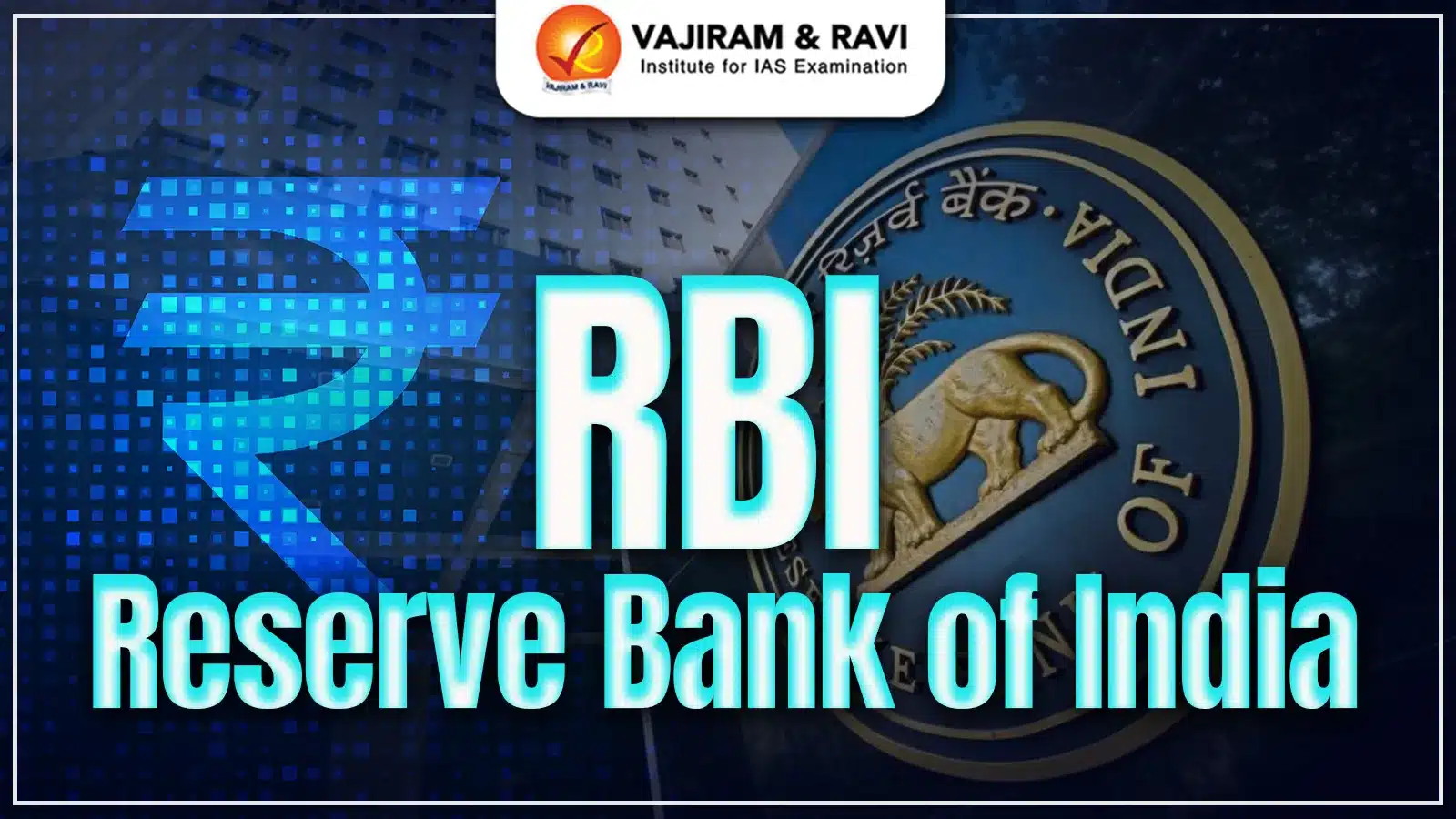India, with its rich cultural heritage, vast geography, and ancient civilizations, has long captivated the imagination of foreign travellers and explorers. From ancient Greek scholars to mediaeval Arab merchants and early modern Europeans, these voyagers travelled the vast subcontinent, leaving behind a wealth of accounts that provided invaluable insights into the country’s past.
Traveller narratives offer a glimpse into the rich cultural traditions, the complex socio-economic structure, and the magnificence of powerful empires. Penned by pioneering figures like Megasthenes, Al-Beruni, Marco Polo, and Bernier, their seminal works have become invaluable repositories, preserving insights into India’s history while enhancing India’s reputation internationally.
Foreign Travellers in India
India mesmerised foreign travellers for ages – ancient Greeks, medieval Arabs like Al-Beruni, and Europeans like Marco Polo and Sir Thomas Roe. They describe India in a lively way, showing its grandness with its rich kings, and different cultures, and how it’s always changing when seen from outside perspectives.
Reasons behind Foreigner’s Visits
Foreign travellers visited the Indian subcontinent for various reasons, including-
- Religious pursuits: Buddhist scholars like Hiuen Tsang from China sought to study the origins and practices of Buddhism in India.
- Trade and commerce: India’s thriving trade networks and markets attracted merchants from various regions seeking business opportunities.
- Cultural exchange: India’s rich heritage in arts, philosophy, and traditions piqued the curiosity of foreign travellers interested in cultural immersion.
- Political missions: Emissaries like Megasthenes were sent on diplomatic missions to establish political and economic ties with Indian kingdoms.
- Scientific learning: India’s advances in astronomy, mathematics, and medicine drew scholars eager to learn from its intellectual traditions.
- Historical documentation: Travellers like Ptolemy aimed to chronicle and record observations about ancient Indian society, geography, and history.
Foreign Travellers during Ancient India
- Megasthenes
- Megasthenes, a Greek ethnographer and ambassador, visited the court of Chandragupta Maurya as an envoy of Seleucus Nicator.
- He wrote the famous work ‘Indika’ which provides valuable information about the Mauryan empire, its administration, society, geography, and culture.
- He is often hailed as the “Father of Indian History.”
- Deimachus
- He was a Greek ambassador to the court of Bindusara, son of Chandragupta Maurya.
- His accounts corroborate and supplement Megasthenes’ descriptions of ancient India.
- Fa-Hien
- Fa-Hien was a Chinese Buddhist monk and one of the earliest Chinese travellers to India. He travelled to India during the rule of Chandragupta II (Vikramaditya).
- His travelogue ‘A Record of the Buddhist Kingdoms’ provides insights into ancient India’s religious and social life during the Gupta period.
Foreign Travellers during Medieval India
- Hiuen Tsang
- Hsüan-Tsang, also known as Xuanzang, was a Chinese Buddhist monk who travelled to India during the reign of Harshavardhana.
- His memoir ‘Great Tang Records on the Western Regions’ provides insights into the religious, political and cultural life of India during this period.
- During his sixteen-year pilgrimage, he traversed the Silk Road and parts of South Asia.
- At Nalanda, he translated Buddhist scriptures, engaged in scholarly pursuits and contributed to the exchange of knowledge between China and India.
- I-Tsing
- I-Tsing, a 7th-century Chinese traveller, visited India during the Chalukya and Pallava rule in the Deccan region.
- His primary purpose was to study and gain knowledge about Buddhist teachings, philosophy, and monastic life in India, which was considered the origin of Buddhism.
- His accounts offer rich insights into Buddhist practices like monastic rules and monks’ daily routines in India.
- Al-Beruni
- He was a Persian scholar, mathematician, and polymath who accompanied Mahmud of Ghazni‘s expeditions to India between 1024-1030 AD.
- He is considered the “Father of Indology” for his pioneering and insightful study of Indian history, culture, and sciences.
- In his seminal work “Tahqiq-i-Hind”, he covered a wide range of topics related to Indian civilisation, including religion, philosophy, literature, science, astronomy, mathematics, geography, chronology, and social customs.
- He translated several Indian works into Arabic, including the Brahmasiddhanta, a Sanskrit text on astronomy and mathematics.
- Al-Masudi
- Al-Masudi, an Arab historian and traveller, visited parts of India and the Indian Ocean islands.
- His book ‘Meadows of Gold‘ contains descriptions of Indian society, religions, and maritime activities.
- His travels and writings provide valuable insights into the cultural and geographical aspects of India and its maritime connections with other regions.
- Marco Polo
- Marco Polo, a Venetian explorer, visited the Indian subcontinent during 1292-1294 CE on his journey to Kublai Khan’s court in China.
- He visited Southern India during the reigns of Rudramma Devi of the Kakatiyas and Pandyan ruler Madverman.
- Observations: The thriving trade, industries, and economic activities in southern India during the late 13th century.
- Ibn Battuta
- Ibn Battuta, the famed Moroccan traveller, arrived in Delhi during Muhammad bin Tughluq‘s reign in 1333 CE
- He served for some time as a judge in the Delhi court.
- Battuta’s travelogue ‘Rihla’ offers a vivid firsthand account of life in Delhi. His narratives unveil the grandeur of the court, the Sultan’s peculiarities, and insights into administration, law and order, and socio-cultural aspects under Tughluq’s rule.
- The Rihla sheds light on taxation policies, currency regulations, public projects, and more. It also captures details of daily lives, festivals, customs, and religious practices across the Sultanate territories he traversed, providing an invaluable peek into 14th-century India.
- Niccolò de’ Conti
- Nicolo Conti, a Venetian merchant and explorer, spent around 25 years travelling in the Indian Ocean region during the 15th century.
- He reached the Vijayanagar Empirearound 1420 CE and spent several years there. He witnessed the reigns of Deva Raya I and Deva Raya II.
- His detailed accounts describe Vijayanagar’s grandeur, providing insights into the empire’s social customs, religious practices, caste system, Hindu festivals, and the practice of Sati.
- Abdur Razzaq
- Abdur Razzaq, a Persian ambassador sent by Shah Rukh of the Timurid Empire, visited Calicut in 1442 CE during the Zamorin’s reign.
- In his memoir “The Journey of Abdur Razzaq,” he vividly described Calicut’s prosperous port, bustling markets, vibrant spice and textile trade, and the presence of foreign merchants.
- His account offers insights into the Zamorin’s court, and administration, and is a valuable primary source on medieval India’s maritime commercial history.
- Athanasius Nikitin
- Nikitin was a Russian merchant who visited India and wrote the famous ‘The Travels of Athanasius Nikitin‘ describing his experiences.
- Nikitin’s writings offer insights into the political conditions, trade activities, social customs, and religious practices prevalent in parts of India during the 15th century.
- Duarte Barbosa
- Barbosa, a Portuguese traveller, spent around 16 years in India, primarily in the regions of Kerala and the Vijayanagara Empire, from the late 15th to early 16th century.
- He provided detailed descriptions of the intricate caste system prevalent in Indian society, highlighting the various castes, their occupations, and social hierarchies.
- He wrote extensively about the prosperous Vijayanagara Empire, Calicut, Cochin and Goa, highlighting their economic importance and cultural diversity.
- Domingo Paes
- Domingo Paes was a Portuguese traveller who visited the Vijayanagara Empire between 1520-1522 AD during the reign of Krishnadeva Raya.
- Paes’s account describes the grandeur, wealth and power of the Vijayanagar Empire under Krishnadeva Raya. He marvelled at the extensive territory, efficient administration, prosperous trade, and formidable military of the empire.
- Fernão Nuniz
- Fernão Nuniz was a Portuguese traveller and horse trader who visited the Vijayanagara Empire in the early 16th century, around 1535-1537 CE, during the reign of Achyuta Deva Raya.
- His accounts provide valuable insights into Hindu religious practices, temples, festivities like Diwali and Holi, the caste system, and cultural aspects of that era.
- Nuniz’s account highlighted the relatively high status, freedom and visibility of women across different classes in 16th-century Vijayanagara compared to contemporaneous European societies.
- He mentioned that the women were experts in astrology, wrestling and soothsaying.
- Jean-Baptiste Tavernier
- He was a French gem merchant, traveller and pioneer of trade with India in the 17th century.
- He made six arduous journeys to India between 1638 and 1668, travelling extensively across the Mughal Empire under the reigns of Shahjahan and Aurangzeb.
- His observations shed light on the decline of the Mughal empire towards the end, the challenges faced and increasing Persian/Central Asian influences.
- He also elaborately discussed diamonds and diamond mines in India.
- François Bernier
- François Bernier was a French physician and traveller who spent around 12 years (1658-1669) in India, primarily in the court of the Mughal emperor Aurangzeb.
- Bernier’s compelling first-hand observations and critiques in ‘Travels in the Mogul Empire’ provide one of the most comprehensive contemporary European accounts of life, society and politics in India during the later Mughal period.
List of Foreign Travellers in India
Since the beginning of time, travellers from all over the world have visited India. This is a list of notable foreign visitors to India, along with information about their visits.
| Country of Origin | Foreign Travellers | Timeline | Description |
| Greece | Megasthenes | 302-298 BC |
– Seleucus Nicator’s ambassador to Chandragupta Maurya – Book “ Indika” |
| Deimachos | 3rd Century BC | – Greek ambassador to Bindusara’s court | |
| Strabo | 64 BC – 24 AD. | – Book “Geographica” | |
| Ptolemy | 130 AD | – Wrote “The Geography of India” | |
| China | Fa-Hien | 405-411 AD |
– Visited during Chandragupta II – Visited Lumbini |
| Hsüan-Tsang | 630-645 AD |
– Came during Harsha’s reign – Studied in Nalanda – Book “Si-Yu-Ki” (The Records of Western World) |
|
| I-tsing | 671-695 AD | – Came during Harsha’s reign | |
| Arab | Al Masudi | 957 AD | – Book “Muruj-ul-Zehab (Meadows of Gold)” |
| Persia | Al-Beruni | 1024-1030 AD |
– Persian scholar who came with Mahmud of Ghazni – Book “Kitab-ul-hind / Tahqiq-i-Hind” |
| Abdur Razzaq | 1443 -1444 AD | – Ambassador of Shahrukh of Timurid dynasty to Zimorin’s court | |
| Morocco | Ibn Battuta | 1333 – 1347 AD |
– Came during Muhammad bin Tughluq’s reign – Served as a judge in Delhi court – His travelogue “RIHALA” |
| Syria/Damascus | Shihabuddin al-Umari | 1348 AD | – Visited Delhi Sultanate during Muhammad bin Tughluq’s reign |
| Italy | Marco Polo | 1292-1294 AD |
– Came during Rudramma Devi’s reign (Kakatiyas) – Also visited Pandhyan kingdom |
| Nicolo Conti | 1420-1421 AD | – Visited Vijayanagar empire | |
| Pietra Della Velle | 1622-1660 AD | – Traveled during Jahangir’s reign | |
| Peter Mundy | 1630-34 AD | – Visited during Shah Jahan’s reign | |
| Nicolao Manucci | 1653-1708 AD | – Served at Dara Shikoh’s court | |
| Russia | Athanasius Nikitin | 1470-1474 AD | – Visited Bahmani Kingdom during Muhammad III |
| Portugal | Duarte Barbosa | 1500 AD | – Visited in Kerala & Vijayanagara |
| Domingo Paes | 1520-1522 AD | – Visited Vijayanagara during Krishnadeva Raya of Tuluv dynasty | |
| Fernao Nuniz | 1535-1537 AD | – Visited Vijayanagara during Achyutdeva Raya of Tuluv dynasty | |
| Netherlands | John Hughen Von Linschotten | 1583 AD | – Gave a valuable account of the social and economic life of South India. |
| Francisco Palsaer | 1620-1627 AD | – Visited Agra | |
| England | William Hawkins | 1608-1611 AD | – Led the first trip to India by the English East India Company. |
| Sir Thomas Roe | 1615-1619 AD |
– Ambassador of James I, king of England. – Visited during Jahangir’s reign |
|
| John Fryer | 1627-1681 AD | – During Shah Jahan’s reign | |
| France | Jean Baptiste Tavernier | 1638-1663 AD | – Visited India during the reigns of Shah Jahan & Aurangzeb |
| Francois Bernier | 1656-1717 AD |
– Came during Shah Jahan’s reign – focused on Dara Shikoh |
Contributions of Foreign Travellers to India
Foreign travellers have made significant contributions to our understanding and knowledge of India’s history, culture, and society through their detailed accounts and observations.
- Documentation of historical events and dynasties: Travellers like Megasthenes, Hiuen Tsang, and Ibn Battuta chronicled India’s political landscapes, administrations, and historical events across dynasties like the Mauryas and Mughals.
- Insights into socio-cultural practices: Their accounts illuminated India’s diverse social customs, religious festivals, art, architecture, and daily life across regions, highlighting the country’s rich cultural traditions.
- Trade and commerce: Merchant travellers like Niccolò de’ Conti, Athanasius Nikitin, and Jean-Baptiste Tavernier documented India’s trade routes, commercial activities, and economic conditions.
- Religious and philosophical exchanges: Buddhist travelers like Fa-Hien, Hiuen Tsang facilitated religious-philosophical exchanges, documenting Buddhist institutions and teachings in India.
- Architectural marvels: Travelers’ vivid accounts of India’s architectural marvels like temples, forts, and palaces, aided historical preservation efforts.
- Comparative perspectives: Foreign travellers’ accounts offer cross-cultural perspectives, revealing how outsiders perceived Indian society, culture, and governance, highlighting differences.
Limitations of their Assessment
- Cultural prejudices: Travellers often viewed Indian conditions through a European lens and portrayed them as the inverse or opposite.
- For example, Niccolo Manucci portrayed Indian customs and practices in a negative light, describing them as “barbarous” and “uncivilised.”
- Language obstacles: Misunderstandings and distorted portrayals due to limited grasp of local languages.
- Selective observation: They mostly focused on elites, nobles, and administration while ignoring the common people’s lived experiences.
- Thomas Roe focused his observations primarily on the mughal imperial court and the nobility.
- Incorrect depiction: Inaccuracies and oversimplifications in depictions arising from limited understanding of complex social structures.
- For example, Barbosa categorized the Indian population into only four castes, failing to capture the complex hierarchies and sub-divisions within the system.
Foreign Travellers in India UPSC PYQs
Question 1: Persian literary sources of medieval India reflect the spirit of the age. Comment. (UPSC Mains 2020)
Question 2: Assess the importance of the accounts of the Chinese and Arab travellers in the reconstruction of the history of India. (UPSC Mains 2018)
Question 3: Fa-hien (Faxian), the Chinese pilgrin travelled to India during the reign of (UPSC Prelims 2025)
a) Samudra Gupta
b) Chandragupta II
c) Kumaragupta I
d) Skandagupta
Ans: (b)
Question 4: According to the Portuguese writer Nuniz, the women in the Vijayanagara Empire were experts in which of the following areas? (UPSC Prelims 2021)
- Wrestling
- Astrology
- Accounting
- Soothsaying
Select the correct answer using the code given below.
a) 1, 2 and 3 only
b) 1, 3 and 4 only
c) 2 and 4 only
d) 1, 2, 3 and 4
Answer: (d)
Question 5: Which one of the following foreign travellers elaborately discussed about diamonds and diamond mines in India? (UPSC Prelims 2018)
a) Francois Bernier
b) Jean-Baptiste Tavernier
c) Jean de Thevenot
d) Abbe Barthelemy Carre
Answer: (b)
Last updated on June, 2025
→ UPSC Notification 2025 was released on 22nd January 2025.
→ UPSC Prelims Result 2025 will be out soon for the CSE held on 25 May 2025.
→ UPSC Prelims Question Paper 2025 and Unofficial Prelims Answer Key 2025 are available now.
→ UPSC Calendar 2026 is released on 15th May, 2025.
→ The UPSC Vacancy 2025 were released 1129, out of which 979 were for UPSC CSE and remaining 150 are for UPSC IFoS.
→ UPSC Mains 2025 will be conducted on 22nd August 2025.
→ UPSC Prelims 2026 will be conducted on 24th May, 2026 & UPSC Mains 2026 will be conducted on 21st August 2026.
→ The UPSC Selection Process is of 3 stages-Prelims, Mains and Interview.
→ UPSC Result 2024 is released with latest UPSC Marksheet 2024. Check Now!
→ UPSC Toppers List 2024 is released now. Shakti Dubey is UPSC AIR 1 2024 Topper.
→ Also check Best IAS Coaching in Delhi
Foreign Travellers in India FAQs
Q1. Who is considered as the father of Indological study?+
Q2. Who wrote the famous book “Rihla”?+
Q3. Name the foreign travellers who visited the Vijayanagara Empire?+




















